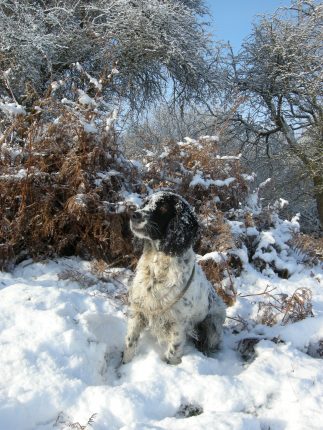It takes more than a bit of rain or snow to put off most keen sportsmen or women but, when the weather really starts to bite, we must put our dogs first, says David Tomlinson
ONE of the great attractions of fieldsports is that, generally speaking, they are not affected too much by the weather. Bad light never stops play, and rarely does bad weather. We all remember those special days when a gale blew, the heavens opened or a blizzard turned the world white. Usually our canine companions carry on regardless, but there are days when it all becomes too much and they become cold dogs.
Many years ago, I was a member of a syndicate in the Sussex Weald. It was a stand one, walk-one shoot, though I usually walked all day because that’s what my spaniels liked doing. On one cold January Saturday, it started raining as we parked the cars; the rain increased steadily as the morning wore on, so by 11am my hat was sodden, my coat was starting to leak and I wasn’t really enjoying myself.

My springer was equally soaked. At the time, she was in her prime and her energy seemed unlimited, but then, quite suddenly, she collapsed. We were in the bottom of a muddy wood, with rivulets of water streaming around us. There was no time to think about what to do, for if she was going to survive it was apparent that I had to act quickly. I wrapped her in my Barbour, then carried her back to the car. It was a mile’s trudge over uneven, sodden ground, the going tricky enough without carrying 20kg of spaniel.
Fortunately, I had a guest with me that day, and he carried my gun while I carried my dog. As soon as we got to the car, we towelled her off the best we could, then settled her in the passenger footwell for the drive home. Thankfully, the warmth from the heater soon started to revive her, and by the time we arrived home she was on her feet again, to my intense relief. She made a complete recovery and never had a similar problem again.
There are a few reasons why a dog might suddenly collapse. In the case of my spaniel, she had simply run out of energy and was overwhelmed by being so cold and wet. It is something that happens occasionally with working spaniels but rarely with labradors. The latter, of course, are not only bigger, so generally more robust, but have a thick double coat that insulates them. In contrast, spaniels are thin-skinned, so are more liable to suffer from sudden loss of body heat.

I have never had a similar experience since, but I have on occasion worked my spaniels in form-fitting neoprene coats that help insulate them. I wouldn’t recommend these coats for a dog that is hunting in brambles, but for a peg dog on a wet day, or a spaniel that goes wildfowling, they can be invaluable. They are small enough to pack in a gamebag, so should your dog look cold and miserable you can always put one on during the day.
Another useful trick is to carry a high-energy food for your dog. One commercial product that I can recommend is Kronch Pemmikan. It comes in a slab, rather like a bar of chocolate, and has sufficient fat, protein and glucose to provide almost instant usable energy for a working dog. Gundog food specialist Skinner’s also offers a handy energy bar containing chicken, apple, carrot and honey to give a burst of nutrients to working dogs.
Feeding chocolate to dogs can be dangerous, as they are unable to cope with the theobromine it contains. However, a friend always used to give his two German pointers half a Mars bar each at lunchtime on a shooting day with no ill effects, and it certainly kept his dogs energised. There’s probably not a lot of pure chocolate in a Mars bar, but there are a lot of calories, while it has the added advantage that you can always eat it yourself if you’re feeling peckish.
It has been quite some time since I last worked my dogs in snow – we haven’t had a fall of any significance on a shooting day for several years. However, after working my dogs one day in heavy snow, I was prompted to buy snowshoes, or what might best be called paw protectors. No, this wasn’t to keep their feet warm, but because the snow balled and froze in their pads, something they clearly found uncomfortable, prompting frequent stops to try to gnaw away the offending ice. I reckoned that with snow boots on, they would be much better prepared for working, but the lack of snow since means that I have not been able to put the boots to the test. Whether I can find them is another matter.
I still get a childish delight from snow, as I love the way it transforms the countryside. Dogs seem to enjoy it, too. However, it can produce problems. Some years ago, I spoke to a picker-up who was working his dogs on a commercial shoot in Scotland on a day of heavy snow. The difficulty, he told me, was that the shot pheasants were falling through the snow so couldn’t be found, even by his labradors. He felt that if you can’t retrieve birds, you shouldn’t shoot them, a sentiment with which I agree.




